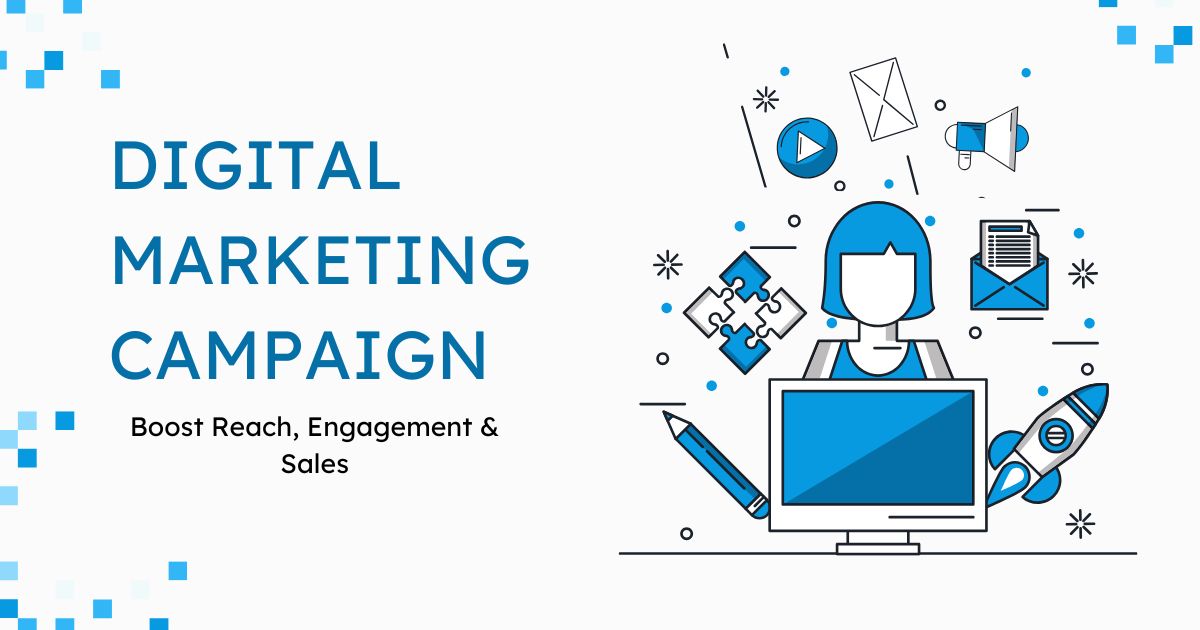
Creating a successful digital marketing campaign can feel overwhelming when you’re staring at dozens of platforms, metrics, and strategies. The good news? You don’t need to master every digital channel overnight or have a Fortune 500 budget to see real results.
This guide breaks down the essential steps to build a digital marketing campaign that connects with your audience and drives meaningful business outcomes. Whether you’re launching your first campaign or refining an existing strategy, these practical insights will help you create campaigns that perform.
Define Your Campaign Goals and Success Metrics
Before diving into tactics, establish what success looks like for your digital marketing efforts. Vague goals like “increase brand awareness” won’t give you the direction you need to make strategic decisions.
Instead, set specific, measurable objectives:
- Generate 500 qualified leads within three months
- Increase website traffic by 40% over six months
- Drive 200 sign-ups for a new product launch
- Boost email subscribers by 25% in the next quarter
Each goal should tie directly to your business objectives. If you’re a SaaS company focused on growth, lead generation might take priority. An e-commerce brand might focus on driving sales and increasing average order value.
Once you’ve defined your primary goals, identify the key performance indicators (KPIs) that will track your progress. These might include click-through rates, conversion rates, cost per acquisition, or return on ad spend.
Research and Define Your Target Audience
Effective digital marketing starts with understanding exactly who you’re trying to reach. Generic messaging aimed at “everyone” typically resonates with no one.
Start by analyzing your existing customers. Look for common characteristics:
- Demographics (age, location, income level)
- Behaviors (how they research products, preferred communication channels)
- Pain points and challenges
- Goals and motivations
Use tools like Google Analytics, social media insights, and customer surveys to gather this data. Create detailed buyer personas that represent your ideal customers, including their preferred platforms and content types.
Consider where your audience spends their time online. B2B professionals might be active on LinkedIn, while younger consumers gravitate toward TikTok and Instagram. This research will guide your channel selection and content strategy.

Choose the Right Digital Marketing Channels
Not every platform deserves your attention or budget. Focus on channels where your target audience is most active and engaged.
Search Engine Optimization (SEO) works well for businesses targeting customers who actively search for solutions. If people search for terms related to your product or service, SEO can drive consistent, long-term traffic.
Pay-per-click (PPC) advertising offers immediate visibility and precise targeting options. Google Ads can capture high-intent searchers, while social media ads excel at reaching specific demographics and interests.
Social media marketing builds brand awareness and community engagement. Choose platforms based on your audience research rather than trying to maintain a presence everywhere.
Email marketing remains one of the highest-ROI digital channels, particularly for nurturing leads and retaining customers.
Content marketing through blogs, videos, or podcasts can establish thought leadership and attract organic traffic over time.
Start with 2-3 channels and execute them well rather than spreading your efforts too thin across every available platform.
Develop Compelling Content and Creative Assets
Your content needs to solve problems, answer questions, or entertain your audience. Generic promotional material won’t cut through the digital noise.
Create content that provides genuine value:
- Educational blog posts that address common customer questions
- Video tutorials that demonstrate product benefits
- Case studies showing real customer success stories
- Interactive content like quizzes or calculators
Maintain consistency in your brand voice and visual identity across all channels. This builds recognition and trust with your audience.
Test different content formats to see what resonates best with your audience. Some respond better to video content, while others prefer written guides or infographics.

Set Your Budget and Allocate Resources
Determine how much you can realistically invest in your digital marketing campaign. Consider both paid advertising costs and the time required for content creation and campaign management.
Allocate your budget based on channel performance and business priorities. If email marketing generates your highest ROI, dedicate more resources there. If you’re launching a new product, you might invest more heavily in paid advertising for immediate reach.
Don’t forget to budget for tools and software you’ll need, such as:
- Marketing automation platforms
- Social media scheduling tools
- Analytics and reporting software
- Design and content creation resources
Start conservatively and increase spending on channels that prove effective. This approach minimizes risk while you test what works for your specific audience.
Launch and Monitor Your Campaign Performance
Once your campaign goes live, monitor performance closely during the first few weeks. This allows you to identify and fix any technical issues quickly.
Track your established KPIs regularly, but avoid making hasty changes based on short-term fluctuations. Give your campaign enough time to generate meaningful data before making adjustments.
Set up automated alerts for significant performance changes. Most advertising platforms and analytics tools can notify you when metrics fall outside normal ranges.
Document what you observe during the launch phase. These insights will inform future campaign optimizations and strategy decisions.

Optimize Based on Data and Insights
Digital marketing’s biggest advantage is the ability to measure and optimize in real-time. Use your performance data to refine your approach continuously.
Look for patterns in your highest-performing content and campaigns. What topics, formats, or messaging generate the best results? Double down on these winning elements.
Test different variables systematically:
- Ad copy and creative variations
- Landing page designs
- Email subject lines
- Posting times and frequency
Make one change at a time so you can attribute performance improvements to specific adjustments. A/B testing different elements helps you optimize based on actual results rather than assumptions.
Measure ROI and Plan Your Next Steps
Calculate the return on investment for your digital marketing campaign by comparing the revenue generated to your total campaign costs. This includes both advertising spend and the time invested in campaign management.
Look beyond immediate conversions to understand the full customer journey. Some customers might discover your brand through social media but convert weeks later through email marketing. Attribution modeling helps you understand how different channels work together.
Use your results to inform future campaigns. Which channels delivered the best ROI? What content formats engaged your audience most effectively? What audience segments showed the highest conversion rates?
Plan your next campaign based on these insights, building on what worked while testing new approaches to continue improving your results.
Start Building Your Digital Marketing Success
A successful digital marketing campaign combines clear objectives, audience understanding, strategic channel selection, and continuous optimization. Start with the fundamentals rather than trying to implement every advanced tactic immediately.
Focus on executing a few key strategies well, measure your results consistently, and refine your approach based on actual performance data. This methodical approach will help you build digital marketing campaigns that drive real business growth.
Ready to launch your campaign? Begin by defining your specific goals and researching your target audience. These foundational steps will guide every subsequent decision and set you up for measurable success.


Leave a Reply